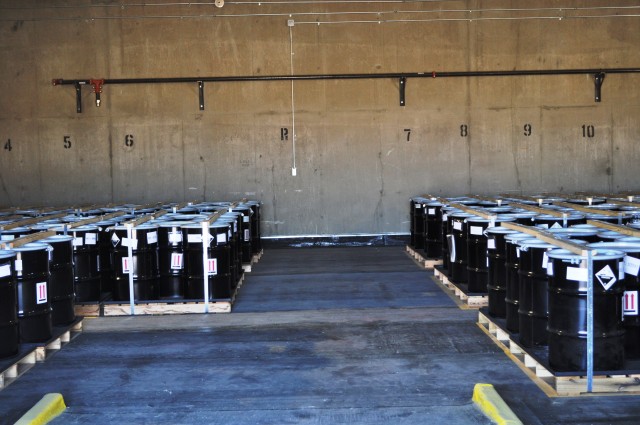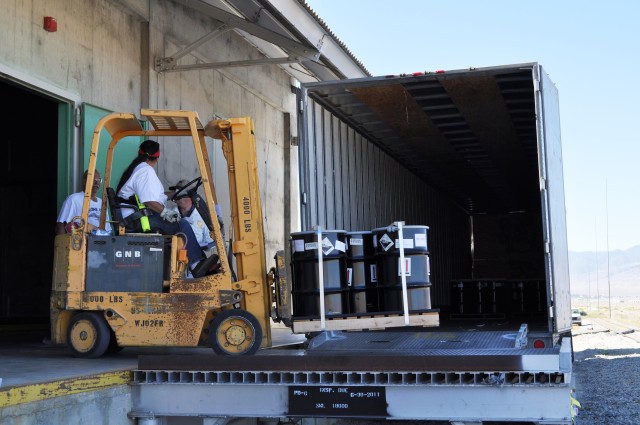HAWTHORNE ARMY DEPOT, Nev. - Teamwork, planning and the careful adherence to state requirements resulted in safe delivery of pilot shipments of elemental mercury here, four years after the depot was selected as its storage site.
The pilot shipments that were completed earlier this month were in compliance with the Chemical Accident Prevention Program (CAPP) requirements of the Nevada Division of Environmental Protection (NDEP).
"Safety is a number one priority at Hawthorne Army Depot, and we're fully confident in our ability to store the mercury safely in a way that protects our workers, community and environment," said Lt. Col. William C. Johnson Jr., HWAD commander.
The Defense Logistics Agency (DLA), through its field activity, DLA Strategic Materials, manages an inventory of 4,890 tons of pure virgin elemental mercury. The mercury is part of the National Defense Stockpile for use in times of national emergency.
The elemental mercury, contained in industry-standard 76-pound iron/steel flasks, has been in storage at three DLA storage sites - Somerville, N.J, Warren, Ohio, and New Haven, Ind.
In February 2006, DLA announced the selection of HWAD as the mercury consolidation location.
During the last four years, HWAD reviewed procedures, equipment and training, upgraded warehouses for mercury storage and installed fire suppression systems. The NDEP required re-inspection and testing of the mercury flasks prior to shipping.
All mercury drums are secure, air-tight and liquid-tight. They are lined, cushioned and sealed with a steel-locking ring that is bolted to seal the drum. The drums are placed on drip pans.
Prior to the start of shipping, Lt. Col. Johnson met with Ronnie L. Favors, administrator,
Defense Logistics Agency Strategic Materials, and Anil Mehta, DLA's legal advisor.
Lt. Col. Johnson also held the following community engagement opportunities regarding the upcoming mercury shipments and storage:
Aca,!Ac Provided notification to the local media regarding the readiness of the depot to store mercury from DLA Strategic Materials at the depot.
Aca,!Ac Met with the Mineral County Commissioners to apprise them of the safety measures implemented for elemental mercury storage at the depot.
Aca,!Ac Met with Tribal Council regarding environmental concerns and assured them of the safety measures involved in the shipment of mercury through the reservation.
As trucks rolled into the depot during the pilot shipments, HWAD's quality assurance personnel performed inspections before, during and after the unloading.
"Anything people are asked to do, they go at it. We have a fantastic team," said Charlene Mills, quality assurance inspector.
"We went through the what-if scenarios and process hazard analyses to satisfy necessary requirements," said Doug Homestead, assistant fire chief at HWAD, who was on hand with fire fighter personnel during the unloading.
"State and NDEP representatives have been at HWAD during the pilot shipments and are satisfied with the process," he said.
Nonetheless, all personnel at HWAD who worked on the trial shipments strove to make the process even better. "We are refining and improving our processes," Homestead said.
Other HWAD team members were on duty during the trial shipments keeping a watchful eye on the trucks, forklift operators and inspectors.
Teresa McNally, storage planner and project manager for the mercury warehouse storage, oversaw the offloading process. Her dedication to making sure the job gets done right showed as she watched pallets move into the warehouses.
"I've worked at the depot for a long time and I can pretty much tell you what is stored in each building here," she said.
Cory Rivero, training officer for HWAD's security force, said that he trained the depot's security guards on the mercury project and emphasized the importance of meeting all of the state's regulations.
The depot's security force is highly trained and the material is protected around the clock by armed security, perimeter fencing and closely controlled access.
Levels of protection at HWAD include closely controlled access; concrete warehouses; security, fire detection and fire suppression systems; sealed warehouse floors and spill retaining berms using mercury impervious liner materials; and spill prevention control and response procedures.
Its skilled workforce specializes in handling hazardous materials such as ammunition explosives, weapons and technical ordnance material, and routine monitoring and inspections of mercury.
Depot operations were crucial to the success of the pilot shipments, but making sure trucking operations went smoothly before arriving at HWAD was DLA's job.
Charles Harder, commodity logistics specialist at DLA Strategic Materials was on site at HWAD during the pilot shipments. He was on call 24/7 while truckers were enroute to Hawthorne. With his cell phone always at the ready, he was available to respond anytime.
"Everything went according to plan. I'm pleased, with the transportation" he said. "Our drivers are trained and certified, and DLA complies with all Department of Transportation regulations."
The NDEP has granted approval for DLA to resume mercury shipments to HWAD later this month. The shipments are expected to continue through mid 2011.




Social Sharing